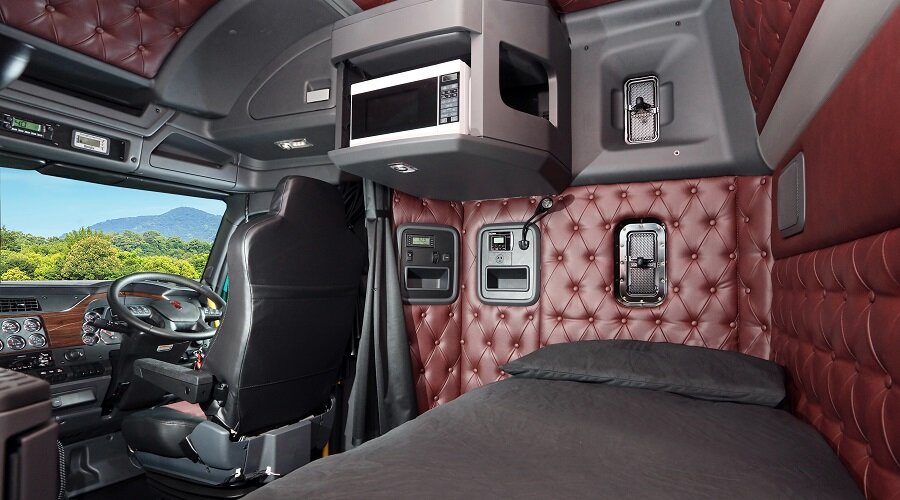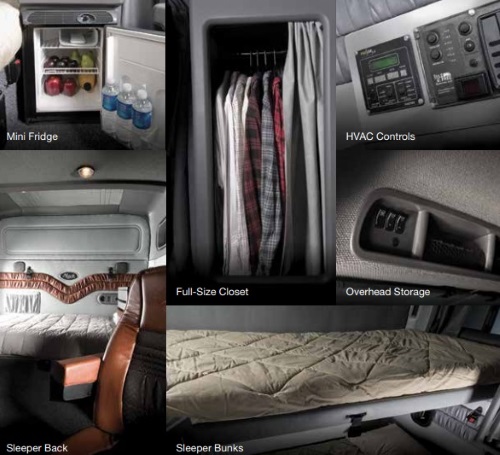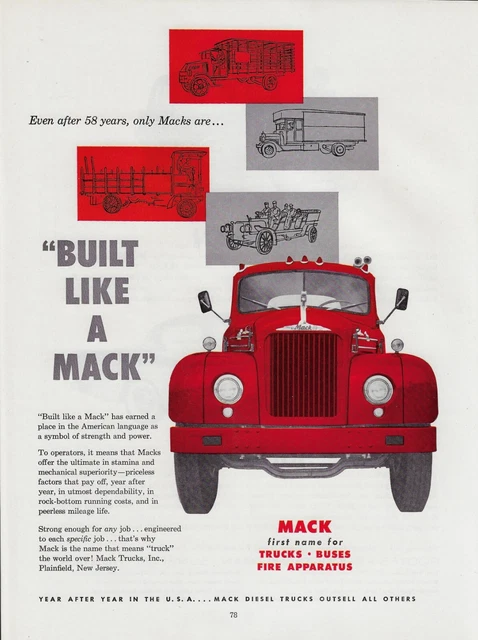Inside Of Semi Truck Sleeper: A Comprehensive Guide to a Driver’s Home Away From Home
Inside Of Semi Truck Sleeper: A Comprehensive Guide to a Driver’s Home Away From Home cars.truckstrend.com
For the uninitiated, a semi-truck sleeper might seem like a mere bunk tacked onto the back of a cab. However, for the millions of long-haul truck drivers who navigate the continent’s highways, the semi-truck sleeper is far more than just a place to rest their head. It is their sanctuary, their office, their kitchen, and their personal space – a veritable home away from home, meticulously designed and often customized to meet the demanding needs of life on the road. Understanding the intricacies of a semi-truck sleeper is to grasp the very essence of the trucking lifestyle, where comfort, functionality, and safety converge to create an indispensable mobile living environment.
This comprehensive guide will delve deep into the world of semi-truck sleepers, exploring their evolution, core components, various types, and offering practical advice for maximizing their potential.
Inside Of Semi Truck Sleeper: A Comprehensive Guide to a Driver’s Home Away From Home
I. The Evolution of the Sleeper Cab: From Bunk to Luxury Suite
The concept of an on-board sleeping compartment for truck drivers is not new, but its evolution has been remarkable. Early iterations in the mid-20th century were often rudimentary, consisting of little more than a cramped, uninsulated bunk squeezed behind the seats, sometimes even an external, detached "doghouse" sleeper. These offered minimal comfort and convenience, primarily serving as a bare-bones necessity to comply with emerging hours-of-service regulations.
As the trucking industry matured and driver retention became a critical concern, manufacturers recognized the need for improved driver welfare. The late 20th and early 21st centuries saw a rapid transformation. Integrated sleepers, seamlessly built into the truck’s cab design, became standard. These offered better insulation, more space, and the introduction of basic amenities. Today, modern sleeper cabs can rival small RVs in terms of features and comfort, reflecting a commitment to driver well-being, which directly impacts safety, productivity, and the overall sustainability of the supply chain.
II. Core Components and Amenities: The Essentials of Mobile Living
Modern semi-truck sleepers are engineered with a focus on maximizing limited space while providing essential comforts. Here’s a breakdown of the typical components and amenities found within:
- Sleeping Area: This is the primary function. Most sleepers feature a single bunk, but many larger models offer double bunks or a convertible dinette that transforms into a second sleeping space. Mattresses are crucial for driver health; while factory-installed options exist, many drivers upgrade to higher-quality innerspring, memory foam, or air mattresses for superior comfort and support.
- Storage Solutions: Organization is key in a compact living space. Sleepers are replete with various storage options:

- Overhead Cabinets: Ideal for clothing, toiletries, and lighter items.
- Under-Bunk Storage: Often accessible from inside or outside, suitable for larger gear, tools, or even a mini-fridge.
- Wardrobe Lockers: Narrow vertical spaces for hanging clothes.
- External Compartments: Accessed from outside the truck, these provide additional storage for larger items not needed inside.

- Climate Control: Maintaining a comfortable temperature is vital.
- HVAC System: The truck’s primary heating and air conditioning system extends into the sleeper.
- Auxiliary Power Units (APUs): These are independent diesel or battery-powered units that provide power for climate control (AC/heat) and electrical outlets without idling the main engine, saving fuel and reducing wear.
- Bunk Heaters/Coolers: Smaller, dedicated units for localized climate control in the sleeping area.

- Power and Connectivity: Drivers need power for their devices and appliances.
- Power Inverters: Convert the truck’s 12V DC power to 120V AC household current, allowing drivers to plug in laptops, microwaves, and other electronics. High-wattage inverters (1500-3000W) are common.
- USB Ports & 12V Outlets: For charging phones, tablets, and other small electronics.
- Wi-Fi/Cellular Boosters: Essential for reliable internet access in remote areas, crucial for navigation, communication, and entertainment.
- Lighting: LED lighting is prevalent due to its energy efficiency and durability. Sleepers typically have overhead lights, individual reading lights for each bunk, and sometimes ambient lighting.
- Entertainment: Many sleepers are equipped with mounts for flat-screen TVs, often wired for satellite TV or streaming devices. Sound systems, sometimes with external speakers, are also common.
- Basic Kitchenette: While not a full kitchen, many sleepers include provisions for basic meal preparation:
- Mini-Fridge: For perishable food and drinks.
- Microwave Oven: For heating meals.
- Counter Space: Often a small fold-down or pull-out surface for food prep.
- Portable Appliances: Many drivers bring slow cookers, hot plates, or portable induction cooktops.
- Personal Hygiene (Advanced/Custom): While most drivers rely on truck stop facilities for showers and full restrooms, some larger or custom sleepers may feature:
- Portable Toilets: For emergencies or convenience.
- Small Sinks: For quick washes.
- Shower Units: Extremely rare in standard factory sleepers, but found in highly customized luxury models.
III. Types of Sleeper Cabs: Tailoring to Needs
Sleeper cabs come in various configurations, each designed to meet specific operational requirements and driver preferences:
- Integrated Sleeper: The most common type, where the sleeper compartment is an integral part of the truck’s cab structure, creating a seamless and aerodynamic design. These range from smaller 48-inch sleepers (measured from the back of the seats to the rear wall) to spacious 80+ inch models.
- Detached/Custom Sleeper: Less common for standard fleets, these are typically aftermarket additions or highly customized units that are essentially a separate, larger living space mounted to the truck chassis behind the cab. They offer significantly more room and amenities, often resembling miniature RVs.
- Mid-Roof vs. High-Roof: This refers to the height of the sleeper.
- Mid-Roof Sleepers: Offer less interior headroom but are more aerodynamic, potentially saving fuel. Standing upright might be difficult for taller individuals.
- High-Roof Sleepers: Provide ample headroom, allowing most drivers to stand up comfortably. They also offer more vertical storage space. While slightly less aerodynamic, the increased comfort often outweighs the minor fuel efficiency difference for long-haul drivers.
IV. Enhancing Comfort and Functionality: Practical Advice
Making a semi-truck sleeper truly feel like home requires personalization and smart organization.
- Invest in a Quality Mattress: This is arguably the most important upgrade. A good night’s sleep is critical for a driver’s health, alertness, and safety. Don’t compromise on mattress quality.
- Master Organization: Utilize every inch of storage. Employ bins, organizers, and collapsible containers. Keep only essentials inside the cab to prevent clutter.
- Efficient Power Management: Understand your inverter’s capacity and your truck’s battery limits. Use energy-efficient appliances. Consider a battery monitor to prevent unexpected power loss.
- Personalize Your Space: Add small touches that make the space feel like your own – photos, a favorite blanket, LED strip lights for ambiance, or even a small plant. This helps combat the loneliness of the road.
- Prioritize Safety and Security: Ensure all windows and doors are securely locked when parked. Use curtains or privacy screens for complete blackout. Consider a carbon monoxide detector if using auxiliary heaters or cooking inside.
- Regular Maintenance and Cleaning: A clean sleeper is a healthy sleeper. Regularly vacuum, wipe down surfaces, and air out the space. Prevent mold by ensuring good ventilation, especially after cooking or if condensation builds up.
V. Challenges and Solutions on the Road
Life in a compact space presents unique challenges, but drivers have developed clever solutions.
- Space Constraints:
- Challenge: Limited room for movement and storage.
- Solution: Multi-functional furniture (e.g., convertible dinettes), vertical storage solutions, and strict decluttering habits.
- Temperature Regulation:
- Challenge: Extreme heat or cold, reliance on engine idling.
- Solution: APUs are the primary solution. Additionally, reflective window covers, good insulation, and portable fans or heaters can help.
- Noise and Light Pollution:
- Challenge: Truck stops can be noisy and brightly lit.
- Solution: Heavy blackout curtains, earplugs, white noise machines, and choosing quieter parking spots.
- Power Drain:
- Challenge: Running appliances can drain truck batteries.
- Solution: APUs, efficient appliances, monitoring battery voltage, and understanding power consumption.
- Hygiene and Waste Management:
- Challenge: No running water or full bathroom.
- Solution: Reliance on truck stop facilities, portable toilets for emergencies, wet wipes, and designated trash disposal systems.
Estimated Costs for Sleeper Cab Enhancements & Features
The "price" of a semi-truck sleeper isn’t a standalone figure, as it’s an integral part of the truck’s overall design. However, the size and features of the sleeper significantly impact the new truck’s purchase price, and many drivers invest in aftermarket upgrades. Here’s an estimated cost breakdown for various aspects related to a semi-truck sleeper:
| Item/Feature | Description | Estimated Price Range (USD) | Notes |
|---|---|---|---|
| New Truck with Basic Sleeper | (e.g., 48-60 inch integrated sleeper) | $120,000 – $180,000+ | This is the base price of a new semi-truck with a standard sleeper. Prices vary widely by make, model, engine, and other specs. |
| New Truck with Premium/Large Sleeper | (e.g., 70-80+ inch integrated sleeper, high-roof, more amenities) | $160,000 – $250,000+ | The larger, more feature-rich sleepers command a higher price. This often includes factory-installed fridges, microwaves, enhanced insulation, and better power options. |
| Aftermarket Mattress Upgrade | High-quality memory foam, innerspring, or custom air mattress | $300 – $1,500+ | A critical investment for driver comfort and health. Factory mattresses are often basic. |
| APU (Auxiliary Power Unit) | Diesel or battery-powered unit for independent climate control & power without idling main engine. | $8,000 – $15,000+ | Significant upfront cost, but saves fuel, reduces engine wear, and improves driver comfort. Can be factory-installed or aftermarket. |
| Power Inverter (High Wattage) | 1500W – 3000W inverter to run household appliances (e.g., microwave, coffee maker). | $200 – $1,000+ | Installation costs (wiring, fuse box) may be additional, potentially another $200-$500 if done professionally. |
| Mini-Fridge (Truck Specific) | 12V DC powered, designed for truck use, often fits specific sleeper compartments. | $300 – $800+ | Factory-installed versions might be included in premium sleeper packages. |
| Microwave Oven (Truck Specific) | Compact, often lower wattage, designed for truck use. | $100 – $300+ | Requires an inverter. |
| Portable Toilet | Basic chemical toilet for emergencies. | $70 – $250 | Not a full bathroom, but provides convenience. |
| TV & Mount | 19-32 inch LED TV with a swivel or articulating mount. | $150 – $500 | Plus costs for satellite receiver or streaming device. |
| Wi-Fi/Cellular Booster | Improves internet connectivity for communication and entertainment. | $200 – $600 | Essential for staying connected on the road. |
| Custom Interior Upgrades | Custom cabinetry, flooring, enhanced insulation, built-in storage solutions. | $1,000 – $10,000+ | Highly variable, depending on the extent of customization and materials used. Often done by specialized aftermarket shops. |
Note: Prices are estimates and can vary based on brand, quality, installation costs, and market fluctuations.
Frequently Asked Questions (FAQ) About Semi-Truck Sleepers
Q1: How big are semi-truck sleepers?
A1: Sleeper sizes are typically measured by their length from the back of the cab seats to the rear wall. They range from small 36-inch "day cab" extenders (for very short rest periods) to common 48-inch, 60-inch, 72-inch, and up to 80-inch or even larger custom sleepers. Height also varies between "mid-roof" and "high-roof" models.
Q2: Do all semi-trucks have sleepers?
A2: No. Trucks used for short-haul, local, or day-trip operations (often called "day cabs") do not have sleepers, as drivers return home at the end of their shift. Sleepers are specifically for long-haul or over-the-road (OTR) trucks where drivers are away from home for extended periods.
Q3: Can you stand up inside a sleeper?
A3: In "high-roof" sleepers, most drivers can comfortably stand upright. In "mid-roof" sleepers, headroom is more limited, and taller individuals may need to stoop.
Q4: How do drivers get power for appliances like microwaves or TVs?
A4: Drivers use a power inverter, which converts the truck’s 12-volt DC battery power into 120-volt AC household current. For extended use of appliances or climate control without idling the main engine, many trucks are equipped with an Auxiliary Power Unit (APU).
Q5: Do semi-truck sleepers have bathrooms or showers?
A5: Standard factory-installed sleepers generally do not have full bathrooms or showers. Drivers typically rely on facilities at truck stops, rest areas, or customer locations. Some larger, highly customized, or luxury aftermarket sleepers might incorporate a portable toilet, a small sink, or even a compact shower unit, but these are exceptions.
Q6: How long can a driver typically stay in their sleeper?
A6: Drivers’ time in the sleeper is primarily governed by Hours of Service (HOS) regulations, which mandate specific rest periods. Drivers can take their required 10-hour off-duty breaks or 34-hour (or longer) resets within their sleeper. Many OTR drivers spend weeks or even months living out of their sleeper, only returning home for longer periods off.
Conclusion: The Indispensable Sanctuary of the Open Road
The semi-truck sleeper is more than just a compartment; it is a meticulously designed mobile living space that serves as the backbone of a long-haul driver’s life. From its humble beginnings as a basic bunk to today’s sophisticated, amenity-rich environments, the evolution of the sleeper cab underscores the critical role it plays in driver comfort, well-being, and ultimately, the efficiency and safety of the entire logistics industry. As technology advances and driver needs continue to evolve, the semi-truck sleeper will undoubtedly continue to innovate, ensuring that the men and women who keep our economies moving have a true home away from home on the endless miles of the open road.






